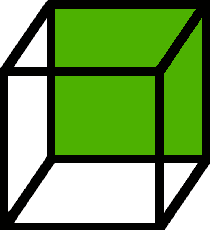
In a class I’m taking on sensation and perception in the human brain, we recently read a research journal article inquiring about how our visual cortex is able to mark the “front” of an object. The “front” of an object must be clarified because in the actual world—set apart from our individual perceptions of the environment—the surface of an object does not have an objective label for its “front.” Instead, we designate this label to objects according to information we receive, such as an object’s direction of motion. But when this information is absent or weak, or has surfaces that have competing cues for being its “front”, we can then flexibly assign the “front” to an object (e.g. which side is the front of a motionless skateboard?). The experimenters, Yangqing Xu and Steven Franconeri from Northwestern University (hssss), test these ideas with a modified Necker cube (Demonstration: http://www.yorku.ca/eye/necker.htm) where two different representations of its possible “fronts” are given for participants to perceive. The participants are required to either change their perception when prompted, or change their perception spontaneously and signal when they view a new perception of the cube.
The Necker cube is important for understanding visual perception because we don’t completely understand the deeper mechanisms of the visual process. We do understand the primary processes of sensation: light energy reflects off of objects into our eye, and then reflects upon the retina, transmitting electrical energy amongst a vast and complicated array of specialized neurons. But after this point, perception of this electrical stimuli is also guided by our conscious awareness of the reflected light energy, which in the aforementioned case is represented as the Necker cube with ambiguous 2D and 3D orientations. Ultimately, the perceptual process is not just a series of steps, rather it is dynamic and constantly changing. When presented with the cube, a baby may only see black lines connected in white space. Then, 20 years later he looks again and is left questioning the realities of his existence…as merely a set of activated receptors combined to form his own consciousness. Food for thought.
Here’s a link to those interested in reading a summary of the journal article: http://spatiallearning.org/index.php/showcase/149-showcase-february-2012-marking-the-front-of-object